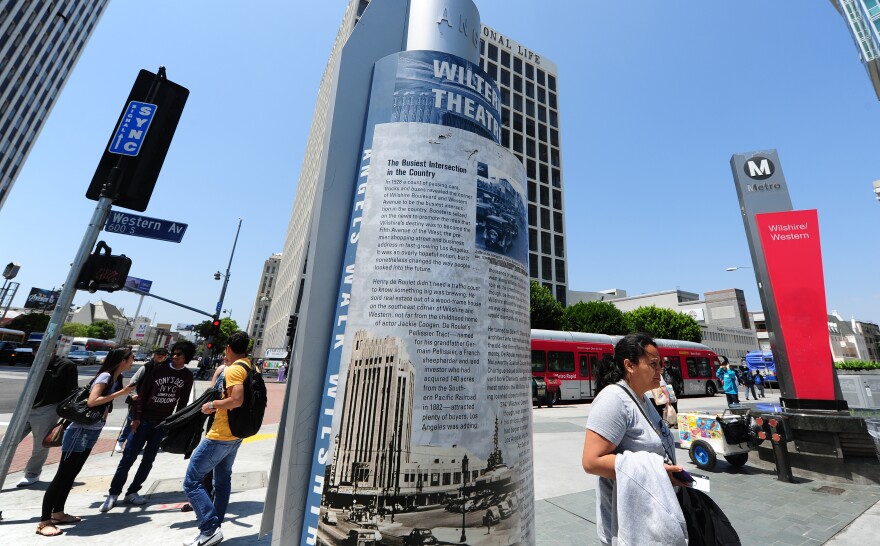Truth matters. Community matters. Your support makes both possible. LAist is one of the few places where news remains independent and free from political and corporate influence. Stand up for truth and for LAist. Make your year-end tax-deductible gift now.
In Tree-Starved Koreatown, More Greenery On Its Way

Amid the wide concrete boulevards and glass-and-steel towers of Koreatown, a grove of shady trees can be hard to find.
A privately-funded tree planting initiative, rare for L.A., is aimed at bringing more greenery — and its cooling impact — to one of the city’s densest neighborhoods.
To date, Koreatown Youth + Community Center has raised more than $600,000 as part of its plan to speed up the rate of tree planting in the neighborhood, most of the money so far coming from a K-Pop impresario who’s made L.A. his second home.
The non-profit currently plants about 1,000 trees a year through an approximately $1 million contract with the city, and expects to add another 1,000 trees in the coming year through the privately-funded initiative. The hope is to exceed a $1 million fundraising goal for the first year, so the program can continue for several years, said Steve Kang, the center’s director of external affairs.
Kang says the project will expand into Ladera Heights, Watts and South L.A., which also have far less tree cover than wealthier neighborhoods.
“Trees not only provide the cooling of the neighborhood, but provide shade for pedestrians who are waiting for buses or walking in the neighborhood,” Kang said.
Private money, public space
Esther Margulies, a professor who teaches landscaping and urbanism at USC’s School of Architecture, lauded the injection of private money into tree planting in open space.
Margulies said aside from mitigating the urban heat island effect, trees help reduce flooding, maintain biodiversity and provide mental health benefits of seeing nature.
“I'm incredibly jealous when I visit other places like the new Tunnel Tops park in San Francisco, or the Little Island in New York, and see what private philanthropy can do for the public benefit and green space,” Margulies said. “Then I come back home to L.A. and think ‘Where's that happening’?”
Margulies works with the city of L.A. through the Urban Trees Initiative to find ways to prioritize tree planting throughout its different agencies. Former Mayor Eric Garcetti in 2019 set a goal to plant 90,000 trees in the city by 2021. (A city spokesperson said Thursday just under 80,000 trees have been planted so far.)
Challenges to tree planting in L.A. are not just financial. Trees are vulnerable to disease and are sometimes removed because of development. There are also limitations to where trees, which need space to establish a root system, can be planted – a quandary very pronounced somewhere like Koreatown, Margulies said.
“There's a setback from the streetlight pole, there's a setback from the corner, there's a setback from a fire hydrant, there's a setback from a parking meter,” Margulies said. ‘There are more setbacks than trees.”
Park-poor
A 2016 report by the L.A. County Department of Parks and Recreation showed that Koreatown had some of the least green space in the region, with 0.1 park acres per 1,000 people compared to 6.5 park acres per 1,000 people in the Brentwood-Pacific Palisades area.
Kang said the community center is creating a needs assessment of where trees are needed the most, and where are the best places to plant.
“Believe it or not, there's quite a bit of the empty wells where the trees were once situated or have died or were damaged over the years that haven't been replaced,” Kang said.
In a neighborhood as vast and tightly-packed as Koreatown, the impact of an additional thousand or so trees a year will depend in large part on whether they’re well-maintained in the first several years and what kind of species are planted, Margulies said.
“There has to be a mental shift from ‘Oh, I love the beautiful flowers on that tree’ to ‘will that tree provide shade’?” said Margulies, who said that oak trees provide some of the most ample canopy.
K-Pop and trees
Half a million dollars has been pledged to the Koreatown planting initiative project by a man known as the godfather of K-Pop. Lee Soo-Man, who founded SM Entertainment, one of South Korea’s largest media companies, lives part-time in L.A. and has stated his commitment to planting trees around the world.
Before his ouster from SM Entertainment earlier this year, Lee held an online summit to promote sustainability in the K-Pop industry. He allegedly pushed to have tree planting worked into the lyrics of one of SM’s top acts aespa.
Lee was in Koreatown with local officials Thursday to help plant the project’s first sapling in Seoul International Park – a hardy gingko which thrives in full sun.

“It will eventually be like 100 feet tall if it's happy,” Margulies said.
About 25 people have contributed to the project including H Mart CEO Ilyeon Kwon, who gave $100,000.








